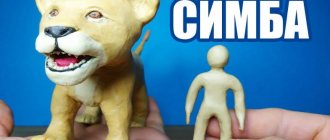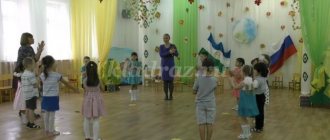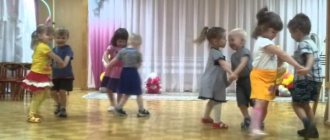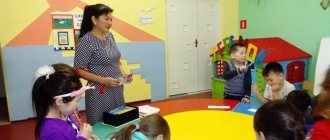Summary of a musical winter thematic lesson in an early age group “Who lives in the forest?”
Summary of a musical thematic lesson for children of the 1st junior group “Who lives in the forest?”
Author: Eskina Svetlana Vladimirovna, music director of MBDOU “Kindergarten No. 37”, Sarov, Nizhny Novgorod region. Description: The notes may be useful to music directors, educators, and preschool teachers. The material is intended for young children. Goal: Development of emotional responsiveness in music lessons. Objectives: - to encourage emotional responsiveness to the expressiveness of music (character, mood), to captivate children with music, enriching their auditory experience; — develop children’s musical-sensory hearing, encouraging them to perceive and distinguish between quiet and loud sounds; - introduce basic singing skills: melodious, drawn-out singing; — consolidate skills in playing musical instruments (bells, tambourine, rattles); - introduce elementary musical-rhythmic skills: “spring”, footsteps, orientation in space: moving “on a sled”, standing in a circle; - encourage active participation in musical outdoor games and perform imaginative roles; - cultivate a friendly attitude towards animals; - activate children's vocabulary. Repertoire: 1. “Hello” by M. Kartushina. 2. “Sleigh” by A. Filippenko. 3. “Music of the Forest” by M. Kartushina. 4. “Tambourine and rattles” by M. Kartushina. 5. “Sleep, my bear” by E. Tilicheeva. 6. “Bunny” Russian folklore, sampled by G. Lobachev. 7. “Children and the fox” by M. Kartushina. Equipment: 1. Media projector.
2. Tape recorder, phonograms. 3. Winter forest scenery. 3. Toys – bunny, bear, fox. 4. Christmas trees, snowdrifts. 5. Musical instruments: tambourine, rattles. Progress of the lesson
A knock is heard on the door. Music director: Knock-knock, knock-knock. A knock is heard from the doors. We open the doors and welcome the children! The children follow the teacher into the hall. Music director: Hello, guys. How beautiful and cheerful you are today! Look, guests have come to us. Let's greet them with our song. Communication game “Hello!”
M. Kartushina. Hello, palms!
Clap-clap-clap! Hello legs! Top-top-top! Hello cheeks! Plop-plop-plop! Chubby cheeks! Plop-plop-plop! Hello sponges! Smack, smack, smack! Hello, teeth! Click-click-click! Hello, my nose! Beep-beep-beep! Hello, guests! Hello! Music director: Do you guys like to travel? (Children's answers) Today we will go to the winter forest. Do you know what animals live there? (children's answers) The animals in the forest are cold and hungry. We will take some treats with us for the animals. For the bear - a barrel of honey (chooses a treat lying on the table), for the bunny - carrots, and for the fox - sour cream. (They put the gifts in the basket.) Now you can hit the road. There is a lot of snow in the forest, we will go on a sled! Song “Sleigh” by A. Filippenko (“riding on a sleigh”).
The sleds themselves are running. The drifting snow is spreading.
And the bells sing loudly in the cold. Ding, ding, ding-ding, blue forests. They go, they go, ding-dilin Sleigh with bells. Educator: So we arrived in the forest. Look how beautiful it is here, everything is covered in snow. (On the screen there is a slide - a winter forest). And here are the stumps, let's sit down and listen to the music of the forest. Listening to the song “Music of the Forest” by M. Kartushina.
The forest stands enchanted, Music sounds quietly, Snow falls quietly, A gentle voice sounds.
The blizzard is sweeping, the blizzard is circling, Snowy music sounds loudly. - 2 times. Music director: Beautiful music near the forest. What is it like? (The music director talks about music, asks leading questions: when a snowball flies quietly - quiet, when the wind howls, a blizzard sweeps - loud). Now the bells will help us show quiet and loud snow music. The song is played again, and the children ring their bells during the transition. Educator: Oh, look, someone is moving under the Christmas tree. Guys, we woke up the clumsy bear. He was sleeping in the den. The teacher takes the bear in his hands and says: Who started dancing here? Who prevents the bear from sleeping? Music director: Misha, don’t be angry, these guys came to the forest and brought gifts for everyone. Take, Mishenka, a barrel of sweet honey for you. Maybe you can play with us? Mishka: I am a bear cub Mishka, I love music. Look, guys, how I hit the tambourine with my paw. The teacher offers to play instruments with the bear. Hand out rattles to children. Game “Tambourine and Rattles” Russian folklore, lyrics by M. Kartushina.
Strike the tambourine with your palm bolder.
All the kids will immediately have more fun. Rattles also want to play. We called our friends and let's dance! Educator: Stop playing, kids. In winter, the bear must sleep. Music director: Guys, let's put the bear to bed, the naughty bear. Children and a teacher with a bear in their hands sit on benches covered with a white cloth. Putting the bear to sleep. Song “Sleep, my bear” by E. Tilicheeva. They put the bear back in the snowdrift.
The teacher notices a white mitten. Teacher (shows the mitten to the children): Guys, look, someone ran here and lost his mitten.
I wonder whose mitten this is - small, white? (children's answers - bunny). Where is he, the cowardly bunny? (They find a bunny under the Christmas tree). Come to us, bunny, don’t be afraid, the guys won’t hurt you. (Children pet the bunny). Get the mitten, don’t lose it again! (Puts a mitten on the bunny). Music director: Come on, kids, let’s sing a song for the bunny. Children sit on chairs. Song “Bunny” Russian folklore, arr.
G. Lobacheva, lyrics by T. Babajan. Bunny Bunny, Little Bunny!
Long ears, Fast legs. Bunny Bunny, Little Bunny! You're afraid of children, Bunny is a coward. (at the end of the song the bunny jumps) Music director: The bunny has become cheerful, he is not afraid of the guys. He wanted to dance with us. And we also have carrots. Shall we dance with them? Shows a basket of carrots. Children stand in a circle and are given carrots. "Dance with Carrots" They collect carrots in a basket and give them to the bunny. Educator: Take some carrots, bunny, we brought them for you. (The teacher puts the bunny under the tree). The bunny got scared and ran under the Christmas tree. Who was he afraid of, guys? The phonogram “Music of the Fox” plays, and on the screen there is a slide with the image of the Fox. Music director: This is a little fox running, rustling its paws, rustling. Fox, don’t scare the bunny, it’s better to play with us. Puts a fox hat on a girl. Game “Children and the Fox”, est. folklore, lyrics by M. Kartushina. Educator: It’s fun to play with you, fox. We also have a treat for you - delicious sour cream. (Give the sour cream to the fox). The fox ran away to its hole. And you and I, guys, have an empty basket, we have treated all the animals. It's time for us to go back to kindergarten. Get in the sled, let's go! Song “Sanochki” by A. Filippenko. Music director: Here we are in kindergarten. Guys, where were we? Who did we meet there? (Children's answers). The animals also sent you gifts. (Takes an envelope with gifts and distributes it to the children.) And now we will say goodbye to the guests and go to the group. The children say goodbye and leave the hall.
We recommend watching:
Children's opera-game "Cockerel" for the second group of early age (from 1 to 2 years old) Summary of a music lesson in the 1st junior group Musical entertainment for the younger group. Toy store Summary of a music lesson in a junior group on the topic: Spring
Similar articles:
Thematic lesson on the theme “Bunny” for children of primary preschool age
Music for children 2-3 years old
We recommend listening to musical pieces with a pronounced visual character. The kids saw a bird, a cat, and a dog; toy and painted bunny and bear, car and rain. And now their “acquaintances” will be represented by music. We recommend the plays: “Birds”, music. T. Lomova or music. G. Frida; “Sparrow” by A. Rubbach or E. Tilicheeva; “Cat” by E. Tilicheeva, “Big Dog” by M. Rauchwerger; “Bear” by D. Shostakovich or E. Tilicheeva or V. Rebikov; “Bear” by M. Rauchwerger or G. Fried; “Rain” by G. Lobachev or V. Fere, “Machine” (“Riding in a Car”) by G. Fried; “Car” by M. Rauchwerger.
This is not a complete list. If you play the piano, you will find a number of other pieces in music books for kindergarten (junior group). Those who do not own an instrument can use the music in audio recordings by purchasing cassettes or CDs. Or contact your friends who play and the music director of the nearest kindergarten with a personal request to record at least a number of plays and songs on tape.
Already in the second year of a child’s life, we include in listening to S. Maikapar’s plays “In the Kindergarten,” “The Shepherd Boy,” “The Moth,” and “The Little Commander.” In the third year of life we add plays by A. Grechaninov “Riding a Horse”, “Dance”; P. Tchaikovsky, “March of the Wooden Soldiers”, “Polka”; E. Grieg's play "Bird"; music by W. Mozart.
You yourself choose from all of the above 10-12 plays per year for children of the second year of life and 12-15 plays for children of the third year of life.
Music directors of nursery groups in kindergartens conduct 2 music lessons per week with children. Now, working under the “Baby” program, V. Petrova is conducting one more lesson with the kids, the third. On it, children listen only to classical music by composers A. Lyadov, S. Prokofiev, D. Shostakovich, D. Kabalevsky, G. Sviridov, as well as the music of I. S. Wach, K. Daken, I. Haydn, W. Mozart, L. .Beethoven, E. Grieg, D. Dvorak.
Musical movement. Dancing.
First year of life
At 6 months, the mother can dance with the baby, holding him in her arms. Movements: walk around the room, stomping merrily; do a half squat (spring), i.e. bend your legs slightly and make small turns left and right; go forward to meet someone from your family, and retreat back; dance slowly, spin around. Perform the movements rhythmically. Try to keep the movements changing in each verse—i.e. at the beginning of each verse.
Music: you can just hum la-la or play a dance recording (low).
Then we complicate the task: humming or playing recorded music, we dance with the baby to two-part music. A two-part form is a musical form characterized by the combination of two parts into a single whole (AB pattern).
The parts are contrasting, differ in new musical material (melody), may differ in tempo (slow-fast), dynamic shades (quieter-louder), etc.
For example: “Where are you, little bunny?”
Part 1 of music: the child is sitting. Mom and baby clap their hands. Mom sings:
Clap, clap, clap, clap (4 claps)
Clap clap, clap, clap. (4 claps)
Part 2 of the music: La-la, la-la-la-la. (Rotate your hands).
La la la la la la. (Rotate your hands).
This dance has a specific music attached to it. It should not sound in other dances. The movements of the first and second parts are the same all the time: The first part is clapping; the second part - the hands are dancing. Then, at the beginning of the second year of life, the baby, even without the participation of the mother, having heard a familiar dance song, will independently repeat the movements, even without singing, only to the music.
So, we teach the baby to listen to music, remember and hear its changes. For this dance we highly recommend the Belarusian folk dance “Yurochka”.
Second year of life
Children in their second year really love the “Aida!” dance. The mother takes the child by both hands, sings and dances.
Part 1(A) Aida, Aida, Aida, Aida, Aida
Part 2 (B) The feet stomped quickly. And Tanya and I danced. (2 lines are repeated 2 times)
Ay
First part (A): baby mothers stand holding each other by both hands, swaying from right to left, waddling from foot to foot, singing along to Aida.
Part 2 (B) Quickly stomp their feet, holding both hands. At the word AI they stop and hide their hands behind their backs.
Third year of life
Note that by the end of the third year, children can easily hear three-part music and change movements in each part. The tripartite form is a common structure of musical works consisting of three sections, of which the third is a repetition of the first. The second is different from the first and third and often contrasts with them. Scheme: (ABA).
If in the poetic text of the dance in each individual verse the action is clearly defined (clap, stomp, squat, spin, bow), and the mother only sings, then the baby dances on his own, without her participation.
By the third year of life, the child masters many dance movements. Can not just clap his hands or knees, but clap his hands while simultaneously tapping with one foot; knows how to click his heel; alternately put your right and left leg forward; spin on your toes. He loves to dance with a doll (bear, bunny), holding it in front of him, spin around, step from foot to foot, sit down and tap the doll’s feet on the floor. He dances willingly with a handkerchief and a rattle.
We adults love to watch kids dance. And we ask, we persuade the child to dance; We promise ice cream cake, a “live dog”, “a ride on a big bike” - the child does not agree. And then we explain to everyone: “He can do it, he’s just afraid! Don’t be afraid, Vovochka, kind, good aunt, dance!” Vovochka didn’t even think of being afraid. He does not want. At this time, he may be occupied by other things: a bird is singing outside the window, dad is drawing in another room with his brother, grandma is cooking something tasty in the kitchen - this is interesting! The child does not want to dance or sing now. But you said the words “Do not be afraid!” and next time the baby may be afraid, because you yourself told him about it.
Do we, adults, always want to sing and dance? And the child has the right not to want.
Attention!
The music cannot be played loudly. Fun, lively - but quiet.
There is no need to invite your child to dance to music that is not intended for dancing.




